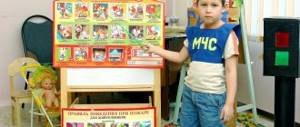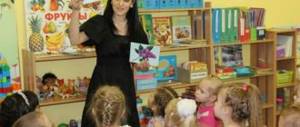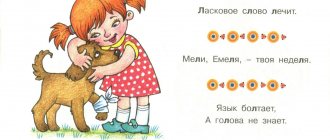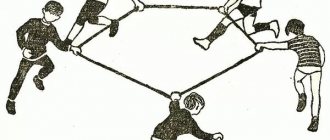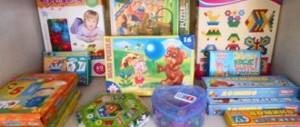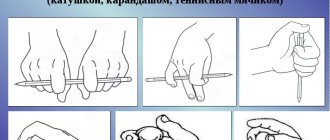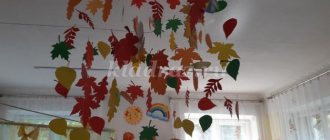Junior group. Early childhood, nursery. Children 1-4 years old
ECD on speech development “Let's help the bunny” for children of an early age group Topic: “Let's help the bunny”
Age: 0-3 years Purpose: Repetition of acquired knowledge in the speech
development of children of the early age group. Objectives: 1. Educational: - Teach children to listen to poetic text and perform the appropriate movements; 2. Developmental : - Develop speech breathing and...
Synopsis of continuous educational activities for speech development “Transport” (early age) Synopsis of continuous educational activities for speech development of the early age group. Theme "Transport"
. Author: Vorobyova Ekaterina Vasilievna Basic educational program of preschool education St. Petersburg, 2020. The theme of the event with children is…
Consultation for parents on children's speech development
Direct educational activities - educational activities for speech development in the second youngest group of kindergarten children - are a key task for teachers. After all, good speech is the basis for productive learning. Information based on the Federal State Educational Standard (FSES) on speech development in the 2nd junior group.
The joint efforts of families and teachers will lead to success in children's learning and speech development.
Consultation for parents on the speech development of children 3-4 years old will help you understand the speech characteristics of preschoolers and find convenient educational games for your child.
Note! Children of the second younger group always learn through play; there is no need or productivity for classical learning while sitting at a desk.
For children 3-4 years old, play is the leading activity; through it children learn about the world. On the part of adults, joining and adapting to the game with didactic intent is the main strategy.
Features of speech development of children 3-4 years old
- The child asks questions about the world with curiosity, provoking spontaneous speech.
- Children's speech is situational, they are not inclined to think about what is said for a long time, analysis and synthesis are still just being formed.
- To make it easier to pronounce complex words, children can swap syllables and remove some of the words: “maracons - pasta”, “shales - slates”.
- 3 years – 4 word sentence; 4 years - adding descriptions of actions into sentences - “what”, “where”, “when”, “why”, “how much”, “how”.
- Begins to capture and describe cause-and-effect relationships.
- Understands the meaning of numbers - singular/plural.
- Agrees relatively competently on the gender - male/female.
- Memory is actively developing - repeating the speech of adults, simple rhymes, songs.
- Children's emotionality and impulsiveness can be heard in the tempo and volume of speech.
Norms of speech development
Norms and standards for speech development of children
- Knows how to give his and his parents' full names and draws basic conclusions in everyday situations.
- Summarizes objects into categories: toys, dishes, clothes.
- Repeats simple sentences after an adult: good morning, time to go to bed, etc.
Note! Adults should be wary of the monotony of a child’s vocabulary if the child’s speech is not enriched. It is important to evaluate progress not in relation to other children, but by looking at your child some time ago.
What to pay attention to
The influence of the family in speech development is difficult to overestimate; To make it easy for parents to memorize, there are rules of three NOTs (to help communication):
- DO NOT remain silent when asked.
- DO NOT mince your words.
- DO NOT impose developmental activities.
In any setting and for all family members: clearly name the sounds made by the object and the words themselves.
You shouldn’t start classes with the words “Let’s learn to speak correctly,” so as not to get a protest. Clear pronunciation and simple exercises should be woven into everyday life without focusing on learning.
Games and activities for home lessons with mom
- Name what you see?
Together with the baby, the mother describes what is drawn in the picture, composes a story about the hero: where he is from, who he is friends with, how he eats, whether there is magic or superpowers, etc.
Game based on the picture: who can name the most objects, elements.
Lesson on speech development in the preparatory group
You can provoke such communication in any situation, even without a picture: “What’s there outside the window?”, “Who do you see on the other side of the street?”, “What time of year, winter or summer? Or maybe spring? Autumn?" etc.
Dialogue with a child on a walk
- Mirror.
The child sits opposite the adult and repeats all facial expressions; he becomes a mirror of the adult. The parent shows his lips like a tube, his tongue is long, his tongue is like a tube, imitation of the sounds O, U, Y, I, A, Z (can be voiced).
A great idea to imitate the sounds of a train, steamship, car, ambulance, and various animals. Then you can change, and the adult will become a mirror of the baby.
- Find a pair.
You need to make cards of similar objects in meaning: cat and kitten, nest and bird, spoon and plate, hut and grandmother, etc. (each picture on a separate card). The child needs to find a pair, help the child voice his findings.
Board game “Match a Pair”
- What will I dream about?
It's a great idea to make it a habit to have these conversations before bed. They will help you calm down, get ready for sleep, relieve tension, and encourage you to speak. Ask leading questions: “what do you want to see?”, “what will happen next?”, “great dream.”
If you don’t like such conversations, you shouldn’t force yourself. Find a topic of conversation that both you and your child will enjoy.
Developmental conversation before bed
- Where's the toy?
The game allows you to reinforce the correct use of prepositions: on, under, about, for. The adult puts the toy on the table and says: “the toy is ON the table”, then puts it down, saying: “the toy UNDER the table” and so on with other prepositions.
The next step is that the parent moves the toy, giving only an excuse, and the baby sits with his eyes closed. When opening it, he needs to find out where the toy is hidden.
Game on correct use of prepositions
Based on the large number of children in kindergarten groups, children receive little individual attention, so it is important to encourage communication at home and encourage them to speak. An attentive parent will not miss the moment when specialist help is needed. After all, without rich, literate speech, further learning will be difficult.
Text of the book “Classes on speech development in the second junior group of kindergarten. Lesson Plans"
Valentina Viktorovna Gerbova
Classes on speech development in the second junior group of kindergarten. Lesson Plans
From the author
The successful implementation of program objectives depends on a number of factors and, above all, on the way of life of a preschool institution, the atmosphere in which the child is raised, and on a specially designed, thoughtful developmental environment.
The effectiveness of education and training is achieved through the painstaking work of teachers who work directly with children and all preschool employees who communicate with preschoolers during the day.
The system of work on teaching children their native language, introducing them to fiction is presented in the works of V. V. Gerbova “Development of speech in kindergarten”, “Introducing children to fiction” (M.: Mozaika-Sintez, 2005).
The manual “Classes on speech development in the second junior group of kindergarten”, written within the framework of the “Program of education and training in kindergarten” edited by M. A. Vasilyeva, V. V. Gerbova, T. S. Komarova, supplements recommendations on the most important direction of pedagogical activity - purposeful and systematic training of preschoolers in the classroom. The practical purpose of the book is to provide educators with approximate guidelines for planning lessons (defining topics and learning goals, ways to implement them).
Features of speech development in children of the fourth year of life
In the fourth year of life, special attention is paid to developing the need to speak out independently
.
Kids speak to communicate, explain, ask for something, and also accompany play actions with speech. One third of their messages and explanations consist of complex sentences, which allows them to improve the syntactic side of children’s speech.
By the age of three, the ability to analyze speech
.
A child, although he himself does not know how to pronounce words correctly, catches when someone else pronounces them incorrectly. Children can distinguish similar sounding words (Sashulka - icicle).
However, it is too early to talk about speech perfection of hearing (coherent speech is more difficult to perceive by ear than individual words).
At this age, children begin to hear and reproduce some intonations (joyful, edifying, interrogative).
Although the fourth year is a period of intensive acquisition of sounds
, along with their correct pronunciation, omission, replacement, assimilation and softening of sounds are observed in children’s speech (the pronunciation of soft sounds is easier for the child than hard ones).
The correct pronunciation of sounds in a child is easily disrupted due to fatigue, illness, or communication with small children who speak poorly.
Pronunciation defects make it difficult to master the grammatical structure of speech and prevent the child from communicating with peers, since his statements are difficult to understand by others.
In children 3–4 years old, breathing is intermittent, and the rate of speech is accelerated (less often, slow), so it can be difficult to listen to them. In this regard, the content of work on developing the sound culture of speech includes exercises to improve breathing, strength, and pitch of the voice.
The problem of forming a dictionary
also has many aspects. It is known that in the third year of life, children easily recognize individual objects (vegetables, furniture, dishes, etc.), but do not always name them correctly. By the age of three, children perceive objects, trying to characterize their signs, qualities, and actions with them.
Understanding some of an adult's questions regarding familiar objects can cause difficulties for children, in particular when the object acts as an object of action. Children, looking at the picture, accurately answer the question “Who (what) is this?” (girl, doll, pants, needle, thread),
but to the question “Who does the girl sew pants for?” some of them answer “The bear is sewing” (just recently the teacher was sewing up the little bear’s pants).
In the dictionary of children of the fourth year of life, significant quantitative fluctuations are recorded, which are explained by the individual characteristics of the development of children.
Unfortunately, researchers still rely on E. Arkin’s data on the composition of vocabulary in children of the fourth year of life, published in 1968. (It is possible that a modern child has different quantitative characteristics.) So, according to E. Arkin, in a child’s dictionary: nouns and pronouns make up 50.2%, verbs - 27.7%, adverbs - 5%, adjectives - 11.8% [ 1].
Children quite successfully master the so-called everyday vocabulary, which helps them communicate. In addition, it is necessary to help children learn words denoting parts and details of objects, their qualities. Some generic concepts should be introduced into the dictionary, otherwise children group objects based on random rather than essential features.
At this age, children intensively master prepositions, conjunctions, and question words (the basis for improving syntax).
Vocabulary work is closely related to work on improving the grammatical structure of speech
(word formation, inflection, etc.).
Children distinguish words based on the prefix, suffix (came - left - came, cup - cup).
Kids master the agreement of singular past tense verbs with nouns, the correct forms of the genitive and accusative plural cases of nouns
(boots, mittens, foxes),
possessive adjectives
(hare, fox);
begin to use adjectives and adverbs in the comparative degree.
It is known that the development of the grammatical structure of speech occurs especially quickly in the second half of the third year of life. (According to researchers, up to three and a half years, and according to some indicators, up to four years, speech does not change significantly.)
In the fourth year of life, the number of simple common sentences gradually increases, and complex sentences appear
.
At this age, children ask questions that are not related to their direct experience. (“This is a rabbit. What’s his last name?” “At night the sun turns into the moon?” “What kind of relative are you?” (Addresses the teacher.))
In the second half of the year, the number of questions aimed at clarifying cause-and-effect relationships increases.
Features of working with children in the classroom
Special classes on speech development and fiction are planned for preschoolers in their fourth year of life. In these classes, work continues to improve the sound culture of speech, grammatical correctness of speech, to cultivate interest in the artistic word and the accumulation of literary baggage.
In the second junior group, classes are most often organized that consist of one part (reading fairy tales to children, practicing clear and correct pronunciation of sounds, etc.). In these classes, in addition to the main one, many other tasks are solved in parallel. So, for example, introducing children to a new fairy tale is the main task of the lesson, but using the same material, the teacher forms intonation expressiveness of speech in children, activates the vocabulary, improves sound pronunciation, etc.
Combined classes consisting of two independent parts are also conducted for children aged 3–4 years. A variety of combination options are acceptable:
• reading a work of fiction and practicing the ability to conduct a dialogue;
• reading (memorizing a poem) and improving grammatical correctness of speech;
• consideration of a plot picture and a game (exercise) to enrich and activate the vocabulary;
• didactic game to develop sound pronunciation and games (exercises) to improve the grammatical structure of speech, etc.
How to achieve optimal “density” of classes, ensure maximum organization and discipline of children, while maintaining the atmosphere of spontaneity and emotionality necessary for their age - this question often arises when working with preschoolers. This problem can be solved by:
• alternating teaching techniques (such as explanation, showing a sample or method of action) with gaming ones. For example, a teacher tells children about a hedgehog song, teaches them to clearly and correctly pronounce the sound f
(by imitation) and practices the pronunciation of sounds using the didactic game “Hedgehog, do you want milk?”;
• alternating choral and individual responses of children (both verbal and motor), which diversify the lesson, help to involve all the children in the work, and significantly increase the speech activity of each of them;
• use of a variety of demonstration materials (toys, objects, pictures, tabletop theater figures, etc.). Their appearance pleases children and helps maintain steady attention;
• using tasks in which children can change their position and move around (look under chairs, looking for a “hidden” dog; show how an important goose stretches its neck, etc.). The playful nature of such tasks encourages the child to accept an imaginary situation. This brings excitement to the activity and prevents fatigue; teaches children play actions. However, this technique will be effective only if the adult himself acts enthusiastically and cheerfully, infecting the children with his mood;
• specially organized communication between the teacher and the children immediately after the lesson. At the invitation of the teacher, the kids look at the toys that were used in the lesson, talk with the teacher, and continue the game that ended the lesson. Inactive children are more willing to answer the teacher’s questions at this time. Such moments allow you to consolidate program material with individual children or a group of children (3–4 people) within 3–5 minutes.
The success of the lesson is largely determined by how the children sit: they must clearly see the teacher and the material being demonstrated. In some classes, it is more convenient for children to sit at tables that are separate from each other; For other children, it is more advisable to seat them in a semicircle; on the third, it is more convenient for younger preschoolers to study at tables located in a row, etc. Children should be seated so that they do not touch each other (especially when imitating actions and movements). It is advisable to have balanced, non-capricious peers sitting next to easily excitable children. You should not ask three-year-old children to raise their hand to demonstrate their readiness to answer, or to stand up when answering a question; this is difficult for children and is associated with a significant investment of time.
The entire way of life of the kindergarten contributes to the development of children's speech.
Work to enrich the knowledge and ideas of preschoolers in all areas of their activities (play, everyday, educational - visual arts, music, the formation of elementary mathematical concepts, etc.) and the development of speech are inextricably linked.
Accurate terminology, based on specific concepts, acquired in a timely manner by preschoolers significantly increases the level of their speech development and improves the culture of verbal communication.
As at the previous age level, the second younger group uses the following vocabulary work techniques:
:
• examination of the item, establishing its purpose; telling children the name of an object, showing characteristic actions with it;
• naming to children the details of an object and their qualities (the teapot has a long nose),
characteristics of the appearance features
(lid on top, handle on the side);
• use of questions that require an action response. These questions allow you to find out whether the desired word is in the child’s passive vocabulary;
• a combination of showing an object with the child’s active actions to examine it (palpation, auditory perception, discrimination by taste, smell). For example, the teacher shows a ficus leaf and says: “Look how big the ficus leaves are. It seems to me that they are larger than Andryusha’s palm. Shall we check? And even bigger than my palm!”;
• repeated repetition by the child of a new word: following the teacher; when answering a teacher’s question; when learning rhymes, etc.
In the second younger group, didactic games are planned to group objects familiar to children: dishes, clothes, toys, furniture, vegetables. Younger preschoolers master and learn to use generalizing words in their speech, name specific objects included in a group, and point to a sign that allows them to combine certain objects that differ in name and appearance.
When working with children, the following sequence is usually used. First, the teacher, using the appropriate moment, shows a group of objects and explains how and why they can be called in one word. Next, he clarifies, concretizes and enriches children’s ideas about the objects included in this group, conducts exercises to activate the vocabulary and, finally, offers tasks for grouping objects.
The acquired knowledge is consolidated in classes and in children’s independent activities.
Many classes, especially in the first half of the year, end with the didactic game “Make no mistake!”, which is carried out as follows. The teacher approaches the child and asks him to complete the task: “A pear, an apple, an orange are... (fruits)”
“Name any vegetable... (any piece of utensils)”, etc.
For the correct answer, the child receives a reward - some small object: a Christmas tree, a chip, a nut, a pebble, an acorn, etc.
At first, the teacher waits for the child to answer the question, but in the second half of the year, teaching children to work at a certain pace, he sets aside a certain time for the answer (for example, he quietly counts to five with the children (later - to three)).
Outside of class, these exercises are carried out during ball games (the child must catch the ball, and while the children count to five (or three), answer the question).
When clarifying children's spatial representations, we need to help them master concepts such as next to me, behind me, in front of me.
The didactic game “What has changed” and various didactic exercises can serve this purpose. For example, the teacher says to the children: “Today you very quickly put up the chairs and got ready to listen. Who is sitting with whom today? Olechka, who is sitting next to you? Who's on the left? On right? Behind? Ahead? And so on.
When mastering color, younger preschoolers experience certain difficulties. They confuse blue and green colors, make mistakes in determining shades, etc. In the process of observations, looking at toys, pictures, clothes, the names of colors should be clarified and activated in children’s speech. This manual provides an example of such an activity - “The nesting doll has a housewarming party.”
One of the complex program tasks is to teach children to use nouns in their speech in the plural form of the nominative and genitive cases. To solve it, everyday processes provide rich opportunities. For example: “So, you got dressed,” the teacher says to the children. – Look, what items of clothing are most abundant today? (Fur coats, jackets, overalls, hats, scarves, mittens...)
What's one thing?
(My coat.)
Alone?
(Olina’s sheepskin coat.)
Alone?
(Dima’s gloves.)”
And so on.
In accordance with the “Program of Education and Training in Kindergarten,” in the second junior group, four classes are allocated for the development of speech and familiarization with fiction.
This manual contains lessons on:
• education of sound culture of speech. The volume of speech material that is used in these classes allows us to simultaneously solve problems of activating children’s vocabulary and forming dialogical speech;
• familiarization with fiction (reading Russian folk tales and poems to children, exercises in dramatization, memorization);
• examining plot paintings. These activities include didactic games and exercises, looking at book illustrations, and dramatization games.
Education of sound culture of speech
In this age group, children are trained to clearly pronounce almost all the sounds of their native language. Only hissing words are excluded (f, sh, h, sch)
and sonorant
(r, l)
sounds, the most difficult to pronounce.
Most children in the fourth year of life clearly pronounce all vowels and many consonants. Then is it worth spending time practicing the pronunciation of these sounds? In answering this question, let us analyze some methodological provisions.
• Clear pronunciation of vowels and the simplest consonant sounds in articulation in many cases contributes to the appearance of sounds that are more complex in articulation in the child. So, in order for speech to be distinct and clear, children must learn to open their mouths well, which is achieved, in particular, by the correct articulation of the vowel sound a;
close your lips tightly - this is facilitated by clear pronunciation of the sounds
m, p, b,
etc.
There is a lot in common in the formation of some vowels and consonants, for example, sounds and
from
.
In both cases, the front of the tongue is tense and raised, air passing through the passage created by the tongue and palate (producing a vowel) or the tongue and the alveoli of the upper teeth (producing a consonant).
Or: when pronouncing the sounds t, d, n,
the tongue is behind the upper teeth, as with the sounds
sh, zh.
The position of the tongue for the vowels
and, uh,
is similar to the position of the tongue for the articulation
of s, z.
Clear pronunciation of the sounds o, u
largely determines the appearance of hissing
w, w, h, shch in a child;
pronunciation
f, v -
whistling
z, s
and sonorant
l;
t, d, n – hissing and sonorous
r, l.
• Nurturing the sound culture of speech is not only about practicing correct pronunciation, although this task is one of the main ones. When practicing sound pronunciation, the ability to distinguish between sounds improves, that is, phonemic hearing, speech breathing, rate of speech, strength and pitch of voice, diction, etc. All these tasks are easier to solve if you use sounds that the child can pronounce well.
The formation of sound pronunciation is carried out in three stages: preparation of the articulatory apparatus; clarification of sound pronunciation; fixing sounds in words, phrasal speech. Let's take a closer look at the last two stages.
Clarifying the pronunciation of a sound
(working on the pronunciation of isolated sounds and onomatopoeia).
Almost all vowels (except o)
and some consonants
(v, f, s, z, ts)
are easy to correlate with any real object: a-a-a - a small child babbles, o-oo-u - a locomotive honks, f -f-f - the hedgehog snorts.
This greatly facilitates the work of sound pronunciation and makes it possible to explain to the child in an entertaining way the need for the next repetition of a sound. For example: “Let's learn to growl as well as a big bear (uh-uh);
let's remind the little bear who forgot the song; Let’s help the little bear call the she-bear,” etc. A variety of techniques increases children’s performance and maintains interest in the material being mastered.
Let's look at the techniques that are used to form sound pronunciation:
• combination of choral repetition with individual repetitions (3–4 repetitions). For example, the teacher says: “Oooh -
The locomotive honks. How does he signal? (Choral answer.) Now let’s listen to how Olin’s locomotive honks... Sashin... Natashin...";
• use of didactic games such as “Wind-up toys”. In this game, children pretend to be baby squirrels (airplanes, mosquitoes, foals). The teacher “turns on” the baby squirrel with a “key”. “Tsk-tsk-tsk” -
says the squirrel. (If the baby is silent, you should not seek an answer; you can explain to the children that the toy is broken.)
Children play these games outside of class, repeating familiar songs (sounds);
• use of the “magic cube”. On the sides of the cube (10–15 cm in size) there are pictures glued: little Alyonushka, a locomotive, a steamship, a foal, etc.
“Turn around, spin around, lie down on your side!” - the children say, while the teacher turns the cube over from side to side. One of the pictures is offered to the children’s attention, and the kids sing the corresponding song in chorus or individually (if there is an airplane in the picture, the children say v-v-v;
water tap -
s-s-s
;
mosquito - s-z-z).
The faces of the cube are filled with pictures gradually as children become familiar with new sounds. By the end of the year, 2-3 cubes are used (alternately) in classes.
It is worth highlighting a group of techniques in which practicing sound pronunciation is a secondary task, and the main thing is the development of speech breathing, speech tempo, and intonation expressiveness:
• children singing “long songs”. Practicing the pronunciation of vowels and sibilants (s, z)
sounds, it is advisable to invite the child to pronounce the sound for a long time (for 2-3 seconds) on one exhalation. You can use the technique of “pulling the thread” (hands are in front - at chest level, the thumbs and index fingers are closed. The child pronounces a vowel sound and at the same time spreads his arms to the sides, as if “pulling the thread”). In this case, you need to monitor the baby’s posture: often, when “pulling the thread,” children lower their heads;
• singing songs (vowels and whistling sounds) with different voice strengths. The song of a large locomotive (steamboat) should be sung in a bass voice, and a toy one - in a higher key (thinly).
Pronunciation of consonant sounds m, b, p, n, t, d, k, g, x
younger preschoolers master it by practicing onomatopoeia.
The techniques that help keep children active and ensure their performance when repeating the same onomatopoeia many times are the same as for practicing the pronunciation of an isolated sound. So, in chorus and one by one, the kids pronounce onomatopoeia while playing wind-up toys (mice - pee-pee-pee,
bells -
ding-dong
, etc.).
The “magic cube” is also used. Ko-ko-ko (kwoh-kwoh, cluck-tah-tah)
- children say if there is a chicken on the side of the cube.
It should be emphasized that at this age stage, onomatopoeia is not so much a means of activating the speech of children - this task was leading in early age groups - but rather a convenient material for developing the sound culture of speech.
By training children to clearly pronounce onomatopoeias, it is easy to provide tasks for distinguishing them ( don-don
and
ding-dong
), on the formation of the tempo of speech, its intonation expressiveness (
kwoh-kwoh-kwoh
- the hen clucks quietly, guarding the chickens,
cluck-clack-clack -
she clucks loudly, alarmed by something).
Consolidating sound in words and phrasal speech.
At this stage, your own teaching techniques are used. Let us dwell on their characteristics.
• Drama games.
As the dramatization progresses, children repeat words and phrases in which the sound being mastered is often found. At the same time, work is being done to develop intonation expressiveness of speech: children pronounce interrogative and exclamatory sentences with intonations of sadness, edification, joy, etc.
Speech material for dramatization games should be selected taking into account the following points:
– a word containing a sound that the child learns to pronounce clearly and correctly should appear at the beginning or end of the phrase;
– sounds that are difficult to pronounce should first be practiced in words in which the syllables are constructed according to the principle of “consonant + vowel”, and not “consonant + consonant + vowel”, since the latter are difficult for a three-year-old child;
– words should be selected so that the paired sound being practiced is hard in some cases, soft in others ( Mila - soap, umbrella - zebra);
– the vowel, the pronunciation of which the child masters, must be stressed.
• Use of poetic lines.
The teacher reminds the children of the passage, then repeats it with them 2-3 times.
Repetition can be done in a playful way. For example, children “bake pancakes and say: “Oh, okay, okay, let’s bake pancakes” (reinforcing the sound a).
The teacher clarifies which book (fairy tale) the passage was read from and recalls its name. (This technique allows you to repeat program works with children without additional time.)
• Reading short new software works
in classes on sound culture of speech.
After reading, the teacher quotes passages from it, rich in words with sounds being practiced, and the children repeat. For example, to reinforce the pronunciation of the sound c,
it is advisable to use the folk song “You Geese, Geese”, the sound
x
- V. Berestov’s poem “Merry Summer” (“Amazing rooster - feathers on top, fluff below; the cunning tail curls, it’s not easy for a girl she wants to laugh, she wants to laugh,” etc.).
• Children repeating words from the teacher’s story.
For example, while reinforcing the pronunciation of the sound
p,
the teacher “introduces” the children to three little mice (toys, pictures) – Pik, Pak, Pok. The teacher sings or recites a song for the little mice, and the names Pik, Pak, Pok that appear periodically in it are pronounced by the children.
• Repetition of pure sayings.
Pure sayings are widely used in working with children. Their effectiveness is beyond doubt. However, in order to develop children’s taste for good literary language, one should be more strict in the choice of pure tongues intended for collective work with children.
So, practicing the pronunciation of any sound necessarily involves clarifying the pronunciation of an isolated sound, and then consolidating it in words and phrasal speech. In a number of cases, this is preceded by the development of a certain position of the tongue and lips, which contributes to the correct articulation of sound.
Classes on developing the sound culture of speech with children of the fourth year of life have the following structure.
I. An exercise that promotes the mobility of the organs of the articulatory apparatus (tongue, lips, etc.) and to some extent ensures clear and correct pronunciation of the sound that children will be introduced to in this lesson.
II. Introducing children to a new sound or onomatopoeia (the teacher pronounces it repeatedly). If possible, the teacher associates a sound or onomatopoeia with a specific image ( f-f-f
- hedgehog song;
ts-ts-ts -
squirrel song;
pi-pi-pi -
the mouse squeaks;
beep-beep -
car honks, etc.)
III. Repeated pronunciation of sound (onomatopoeia) by children. To do this, the teacher offers 3-4 onomatopoeias (fu, fu, uff; bam, bim-bom, bayu-bayu-bayu).
The teacher, as a rule, includes onomatopoeia in his story (or dramatization), accompanied by the display of visual materials. In this part of the lesson, kids perform tasks to distinguish onomatopoeia; reproduction of a given speech tempo, strength and pitch of voice; practicing free, smooth, long (2-3 seconds) exhalation.
IV. Consolidating sound in words and phrasal speech. For these purposes, the following are used: the teacher’s story (without showing or with showing individual objects and actions); dramatization of a short story (fiction text; story invented by the teacher); finishing words in poems familiar to children; didactic and outdoor games.
Speech development through theatrical activities in the younger group
Theatrical activity is a wide field for the development of many mental processes and qualities, including speech. Children are interested in trying on different roles. Like any actors, children need to memorize the text of performances, and voluntary memorization is not yet fully formed.
Memorization process
A number of tips can help parents and teachers with this: choose short and interesting passages for the child to memorize; do not force him to memorize, let him start this only in a good mood, when you have enough free time; Pictures will help you learn abstract text - make an outline of the text in pictures that are understandable to the baby.
Literary material
Choose age-appropriate and familiar material for theatrical activities: “Turnip”, “Teremok”, “Three Bears” and other folk tales, Barto’s poems - in other words, classics of children’s reading will be a good choice.
Scheme of the relationship between theatrical activity and the development of mental processes in children of the third year of life.
Younger preschool age is a time of activity for many sensitive periods; this is the peak of the development of cognitive processes: perception, attention, memory, thinking, imagination, as well as the development of arbitrariness and speech.
Note! Theater is an accessible way to solve problems of pedagogy and psychology, moral education, development of communication abilities, speech, etc.
Stimulating work on the development of speech in younger preschoolers
Based on the information provided, you can easily create a lesson on speech development involving theatrical activities. For better understanding, below is an example of such an activity:
- Conversation on the topic “Is this a theater?”
- Didactic games for fairy tales: “Who is hiding in a fairy tale?”, “Make a fairy tale” cut puzzle, “Who is the odd one out?”, “Find out by the contour”, “Who is behind whom?”, “Find a pair”, “What’s missing?”, “Find the artist’s mistakes”, “From which fairy tale?” Fairy tales are familiar to children and they will be able to discuss them in a group.
- Maze games based on fairy tales.
- Voice imitation games: “Whose voice is this?”, “What makes that sound?”
- Reading fairy tales, poems and theatrical performances.
To summarize, I would like to note that speech development is a complex work of teachers and families. The culture of communication in the family determines the child’s speech. If parents are attentive to the baby and stimulate his speech, then help will not be needed. However, if adults doubt the adequacy of speech development, do not hesitate to contact specialists so as not to miss violations.

